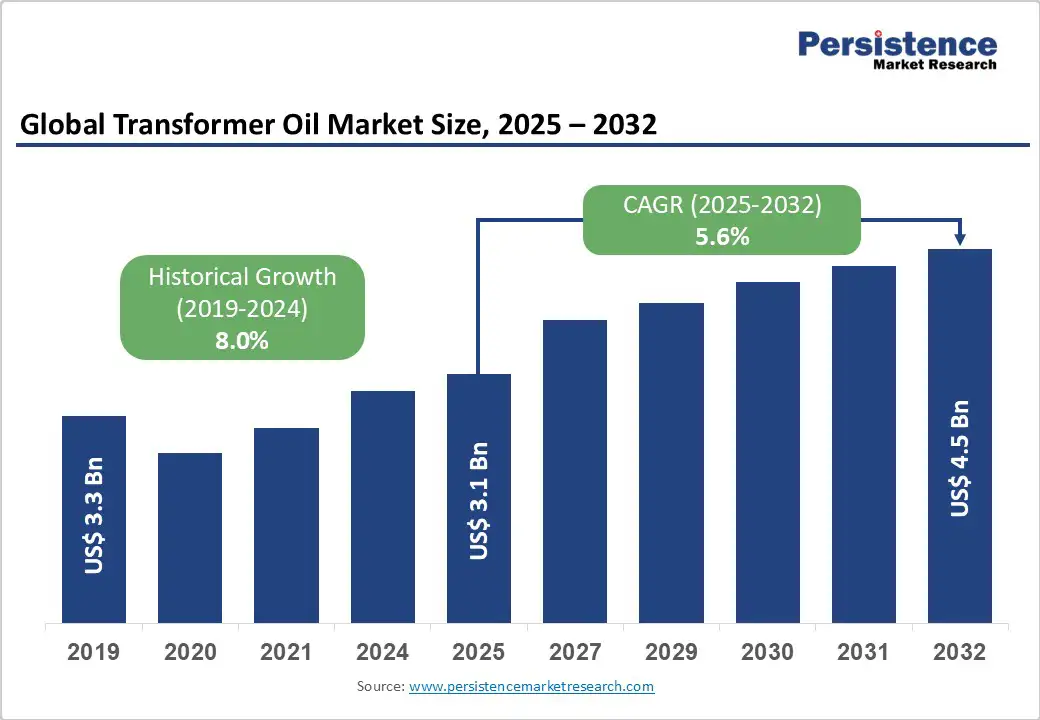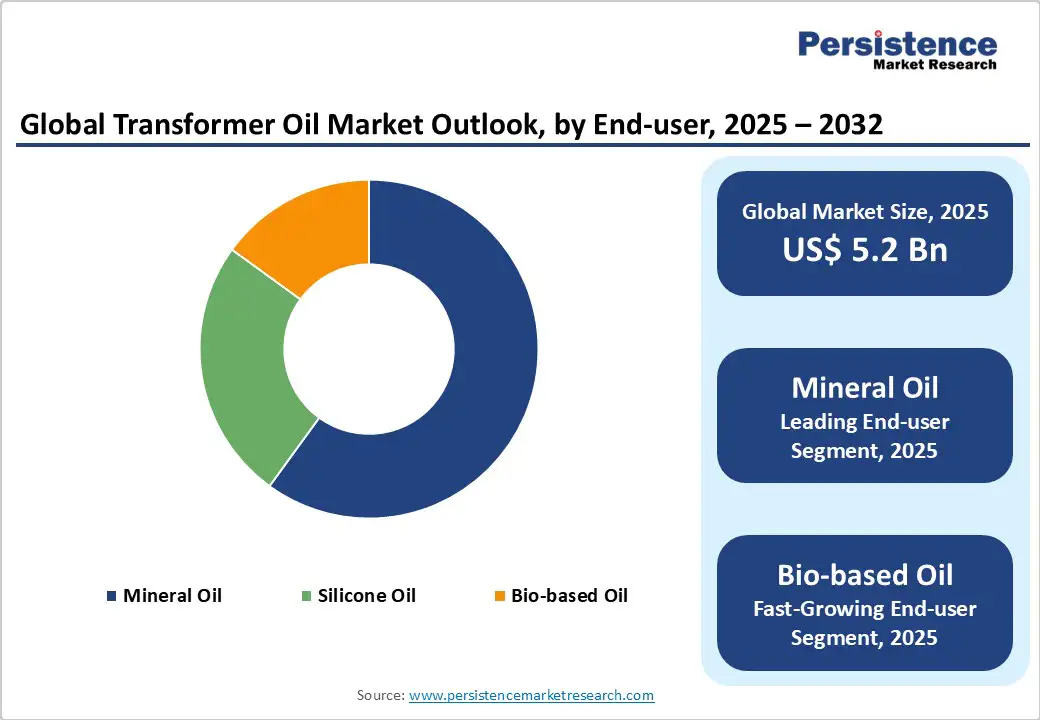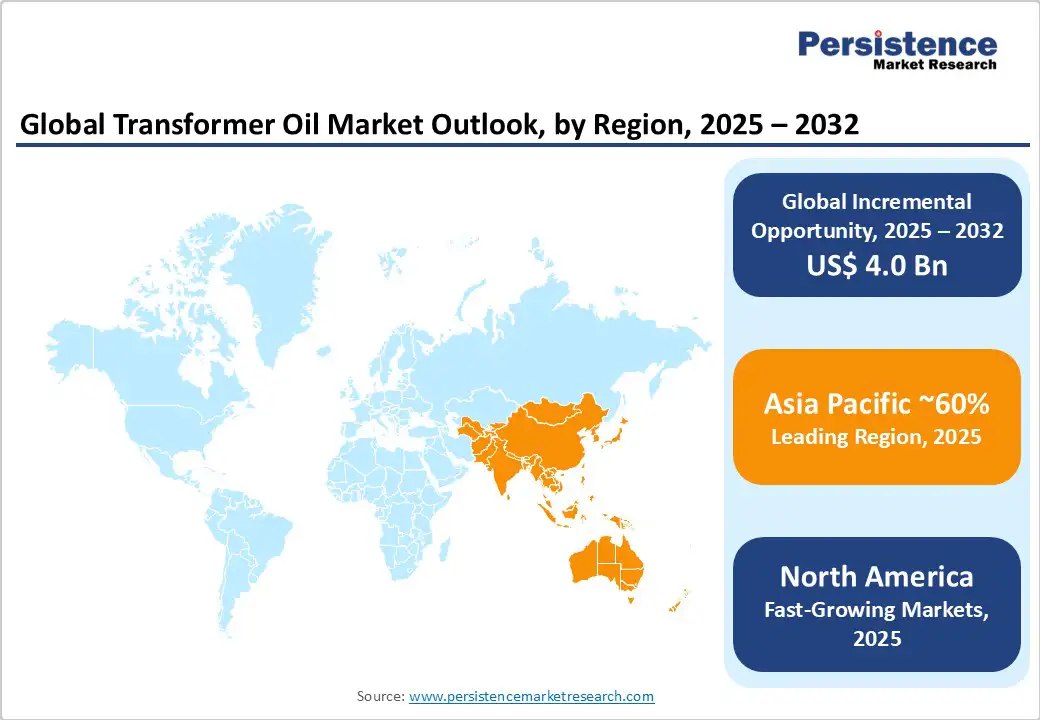ID: PMRREP33160| 200 Pages | 17 Oct 2025 | Format: PDF, Excel, PPT* | Chemicals and Materials

The global transformer oil market size is expected to be valued at US$3.1 billion in 2025. It is projected to reach US$4.5 billion by 2032, growing at a CAGR of 5.6% during the forecast period of 2025-2032. The expansion of electricity grid infrastructure and the integration of renewable energy drive market growth, as utilities prioritize reliable insulating fluids with superior cooling and dielectric properties.
The International Energy Agency (IEA) reports that global grid investment reached $ 400 billion in 2024, reflecting accelerated transmission and distribution modernization across both advanced and emerging economies. Rising electrification needs in the transportation, industrial, and urban sectors further amplify transformer oil demand.
| Key Insights | Details |
|---|---|
|
Transformer Oil Market Size (2025E) |
US$3.1 Bn |
|
Market Value Forecast (2032F) |
US$4.5 Bn |
|
Projected Growth CAGR (2025-2032) |
5.6% |
|
Historical Market Growth (2019-2024) |
5.1% |

Accelerating grid modernization initiatives and renewable energy capacity additions represent the primary growth catalyst for transformer oil demand. According to the IEA, electricity grid investment stagnated at approximately US$300 billion annually from 2015 to 2022, but surged to US$400 billion in 2024, driven by policies in Europe, the United States, China, and Latin America. The U.S. DOE announced US$1.5 billion in grid modernization investments in October 2024, alongside US$2.2 billion for eight transmission projects across 18 states, potentially expanding grid capacity by approximately 13 GW. This infrastructure expansion directly correlates with increased transformer installations and the corresponding requirements for insulating fluid.
Railway electrification programs across emerging economies create substantial demand for specialized transformer oils used in traction transformers and auxiliary power systems. India's Ministry of Railways reported that approximately 98% of the broad gauge network has been electrified as of March 2025, with the balance sections under active development.
China, Japan, and ASEAN nations are investing heavily in high-speed rail and metro infrastructure, with traction transformer markets demonstrating robust growth trajectories. Metro systems, which accounted for 32.4% of railway traction inverter demand in 2025, require high-performance insulating fluids to ensure operational reliability in densely populated urban corridors. The Industrial Control Transformer Market benefits from similar electrification trends, as industrial facilities upgrade power systems to accommodate automated manufacturing processes.
Regulatory frameworks governing polychlorinated biphenyls (PCBs) in transformer oils impose significant compliance burdens on manufacturers and utilities. The U.S. Environmental Protection Agency (EPA) mandates that transformer oil containing PCBs at concentrations of 50 parts per million (ppm) or greater must be treated as hazardous waste under the Toxic Substances Control Act (TSCA), requiring disposal at licensed high-temperature incineration facilities. Testing protocols require chemical analysis using the EPA SW 846 Method 8082, with documentation maintained for at least three years after disposal. Similar regulations exist in Europe under the Integrated Pollution Prevention and Control (IPPC) Directive and the Hazardous Waste Regulations 2005, which elevate operational costs and limit formulation flexibility for traditional mineral oil producers.
Mineral oil-based transformer fluids have also been vulnerable to crude oil price fluctuations that can reach 30% swings within annual cycles. This feedstock volatility directly impacts production economics for naphthenic and paraffinic oil variants, compressing profit margins during price spikes. The correlation between crude oil markets and transformer oil production costs introduces uncertainty for long-term supply contracts, potentially delaying procurement decisions among cost-sensitive utilities in emerging markets. Alternative feedstock options, such as silicone and bio-based oils, face their own supply chain challenges, although they offer partial insulation from petroleum market dynamics.
The growing environmental consciousness and the mandates of a circular economy create substantial opportunities for the adoption of bio-based transformer oil. For example, Savita Oil Technologies Limited has developed bioTRANSOL HF, a natural ester fluid derived from renewable vegetable oils that is readily biodegradable according to US EPA OECD 301B standards and certified by UL for fire safety. These bio-based ester fluids hold a significant market share within the bio-based transformer oil segment, offering superior fire safety with higher flash points. Natural esters provide K-class insulation ratings, making them ideal for urban substations and environmentally sensitive installations.
At the same time, emerging Internet of Things (IoT) technologies and artificial intelligence (AI)-driven monitoring systems are generating a huge demand for transformer oils optimized for sensor compatibility and real-time performance tracking. Predictive maintenance models that integrate fluid condition monitoring can reduce transformer downtime by up to 25%, according to industry estimates, creating commercial opportunities for oil producers who partner with technology vendors. Siemens and Microsoft, for instance, announced collaborations in October 2023 to integrate AI services with industrial operations, exemplifying the convergence of digital technologies and traditional equipment assets.
Mineral oil is likely to command approximately 60% market share in 2025, sustained by cost-effectiveness, established supply chains, and proven performance across diverse operating conditions. Naphthenic oil variants offer superior low-temperature performance, with pour points reaching -40°C, making them preferred for cold-climate installations. In contrast, paraffinic oils provide excellent oxidation stability for tropical and high-temperature environments. The extensive refining infrastructure for petroleum-derived transformer oils ensures consistent quality and competitive pricing compared to specialty alternatives. Despite environmental pressures favoring bio-based and silicone fluids, mineral oil maintains its dominance due to backward compatibility with legacy transformer fleets, which represent 60 million to 80 million distribution transformer units currently in service globally.
Transformers are set to account for approximately 65% of transformer oil consumption in 2025, with power transformers representing the largest sub-segment due to high-voltage transmission requirements and substantial fluid volumes per unit. Distribution transformers follow closely, benefiting from grid expansion programs and rural electrification initiatives. The Central Electricity Authority (CEA) of India reported the addition of 86,433 MVA of transformation capacity in 2024-25, reflecting the scale of infrastructure deployment driving oil demand. Power transformers serving renewable energy integration require specialized fluids that can handle variable load profiles and rapid thermal cycling, creating opportunities for premium product formulations.
Transmission & distribution is slated to dominate with approximately 50% market share in 2025, driven by infrastructure investments across developed and emerging economies. For example, the National Electricity Plan (NEP) of India projects the addition of approximately 191,474 circuit kilometers of transmission lines and 1,274 GVA of transformation capacity by 2031-32, representing capital expenditure exceeding? 9 trillion in inter and intra-state networks. Grid reinforcement programs in North America and Europe focus on integrating renewable energy sources and enhancing resilience against extreme weather events, necessitating the use of transformer oil for both new installations and existing asset refurbishment.

Asia Pacific is predicted to command approximately 60% of the transformer oil market share in 2025, bolstered by massive infrastructure investments across China, India, and ASEAN nations. China's transmission and distribution network expansion supports the integration of renewable energy and urbanization, with state-owned utilities maintaining substantial transformer fleets. The nation's leadership in silicon carbide (SiC) technology production enhances its railway electrification programs, indirectly supporting demand for transformer oil through traction transformer applications.
India demonstrates exceptional growth potential, with the government targeting 500 GW of renewable energy capacity by 2030, including 280 GW of solar and 140 GW of wind, which will require extensive additions to transmission infrastructure. ASEAN countries, including Vietnam, Indonesia, and Thailand, invest heavily in metro rail systems and power generation capacity, creating demand for both mineral and bio-based transformer oils. Local manufacturing capabilities in India and China offer cost advantages, although quality standards are increasingly aligning with international specifications, such as IEC 62770, for natural ester fluids.
North America is anticipated to exhibit the fastest regional growth, propelled by comprehensive infrastructure legislation and renewable energy targets. The U.S. Infrastructure Investment and Jobs Act and subsequent grid modernization initiatives allocate billions toward transmission upgrades and distribution network reinforcement. Investment by U.S. investor-owned electric utilities reached US$186.4 billion in 2024, with approximately 80% directed toward infrastructure, supporting robust transformer oil consumption.
In September 2025, the U.S. Department of Energy's Grid Deployment Office launched the 'Speed to Power' initiative to accelerate the development of large-scale grid infrastructure projects. This initiative aims to meet the growing electricity demand from sectors such as artificial intelligence and data centers by streamlining permitting processes and enhancing grid resilience. Canada contributes through interprovincial transmission projects and smart grid pilots, emphasizing the use of bio-based fluids for environmental protection in ecologically sensitive regions.
The market for transformer oil in Europe benefits from regulatory harmonization under the electrical equipment directives of the European Union (EU) and its aggressive decarbonization targets that are driving investments into grid infrastructure enhancement. Germany leads regional demand through its renewable energy transition (Energiewende), which necessitates extensive grid reinforcement to accommodate wind and solar capacity. The United Kingdom emphasizes the integration of distribution automation and offshore wind, requiring specialized transformer oils with enhanced fire safety characteristics for populated urban substations.
France and Spain have been investing in cross-border interconnectors and substation modernization, with emphasis on low-temperature performance fluids for mountainous regions. European utilities increasingly specify bio-based and silicone transformer oils to align with EU environmental objectives and circular economy principles. The expansion of the electric power distribution automation systems market across Europe correlates with the demand for premium transformer oils, which support advanced monitoring and control technologies.

The global transformer oil market structure exhibits moderate consolidation with global petroleum majors and specialized lubricant manufacturers competing alongside regional producers. Leading companies differentiate through product innovation, particularly in bio-based and silicone fluid categories, and geographic expansion via regional blending terminals that reduce logistics costs.
Strategic partnerships between equipment original equipment manufacturers (OEMs) and fluid suppliers facilitate the co-development of application-specific formulations optimized for modern transformer designs. Research and development investments focus on extending fluid service life, enhancing biodegradability, and improving compatibility with digital monitoring systems. State-owned enterprises, particularly in the Asia-Pacific and the Middle East, maintain significant market positions through captive supply chains that serve national utility companies.
The global transformer oil market is projected to reach US$ 3.1 billion in 2025.
Expanding electricity grid infrastructure, active renewable energy integration, and increasing prioritization of reliable insulating fluids by utilities are driving the market.
The market is poised to witness a CAGR of 5.6% from 2025 to 2032.
Developing IoT-enabled predictive maintenance fluids and bio-based alternatives and tapping into the accelerated modernization of electricity transmission and distribution systems across advanced and emerging economies are key market opportunities.
Royal Dutch Shell, Exxon Mobil Corporation, and Repsol are some of the key players in this market.
| Report Attribute | Details |
|---|---|
|
Historical Data/Actuals |
2019 - 2024 |
|
Forecast Period |
2025 - 2032 |
|
Market Analysis Units |
Value: US$ Mn/Bn, Volume: As Applicable |
|
Geographical Coverage |
|
|
Segmental Coverage |
|
|
Competitive Analysis |
|
|
Report Highlights |
|
By Oil Type
By Application
By End-Use
By Region
Delivery Timelines
For more information on this report and its delivery timelines please get in touch with our sales team.
About Author